Hootsuite’s Billion-Dollar Content Repurposing Menu
You’ve probably heard these sayings multiple times:
“Content is king.”
“Content rules.”
“Create engaging content to drive traffic.”
While creating more content sounds like a great plan, let’s be honest.
Currently, there are over 600 million blogs on the internet.
Most of these blogs barely get any traffic.
The ones that get good traffic have to invest time, effort, and $$ to create multiple high-quality long-form blog posts that hit the mark with their audience.
And let’s face it. Not all marketing teams have the bandwidth to keep up with creating content from scratch, especially if the previous blog posts didn’t perform very well.
To improve ROI, every marketing team needs to focus on repurposing existing content and spend less time creating new content.
Hootsuite understands the value of content repurposing.
The billion-dollar social media scheduling company invests in remixing existing content into different formats that fit the different distribution channels they leverage.
They create once, distribute forever in many different ways.
Let’s see what Hootsuite’s content repurposing menu looks like.
Want The Latest SaaS & Marketing Insights Delivered To Your Inbox?
Sign up to get exclusive insights and information that isn’t published anywhere else.
SUBSCRIBE NOW
Mục Lục
What’s On Hootsuite’s Content Repurposing Menu?
When I first landed on Hootsuite’s Instagram page, I was impressed by their catchy designs and content:
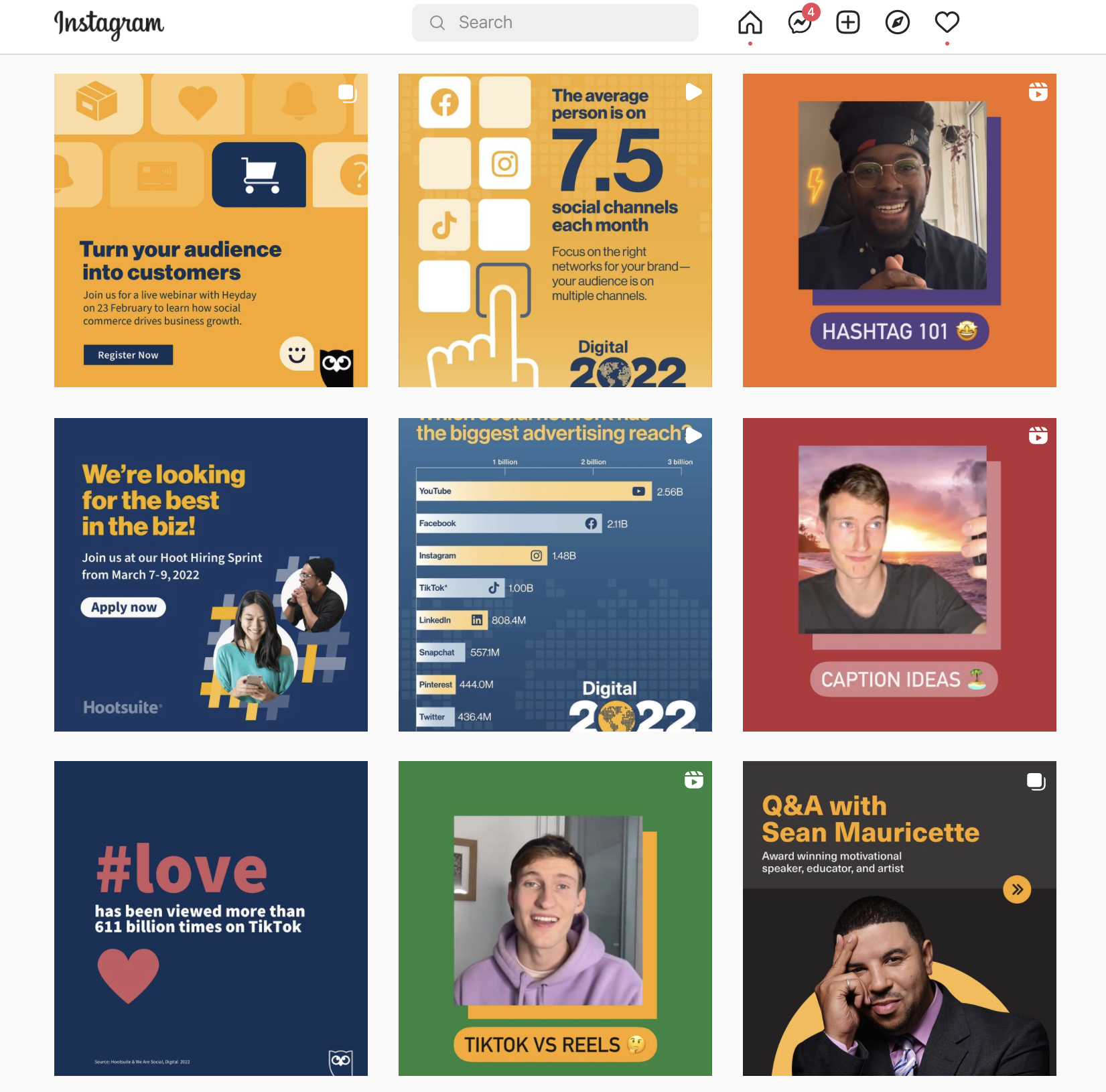
So, I set out to break down Hootsuite’s Instagram marketing strategy.
However, when I checked out their other social channels, I realized Hootsuite wasn’t just killing it on Instagram. They designed a whole content repurposing menu, leveraging their social reach to increase their organic reach.
See how many eyes Hootsuite could potentially turn their way if every one of their followers on these social media channels saw their content:
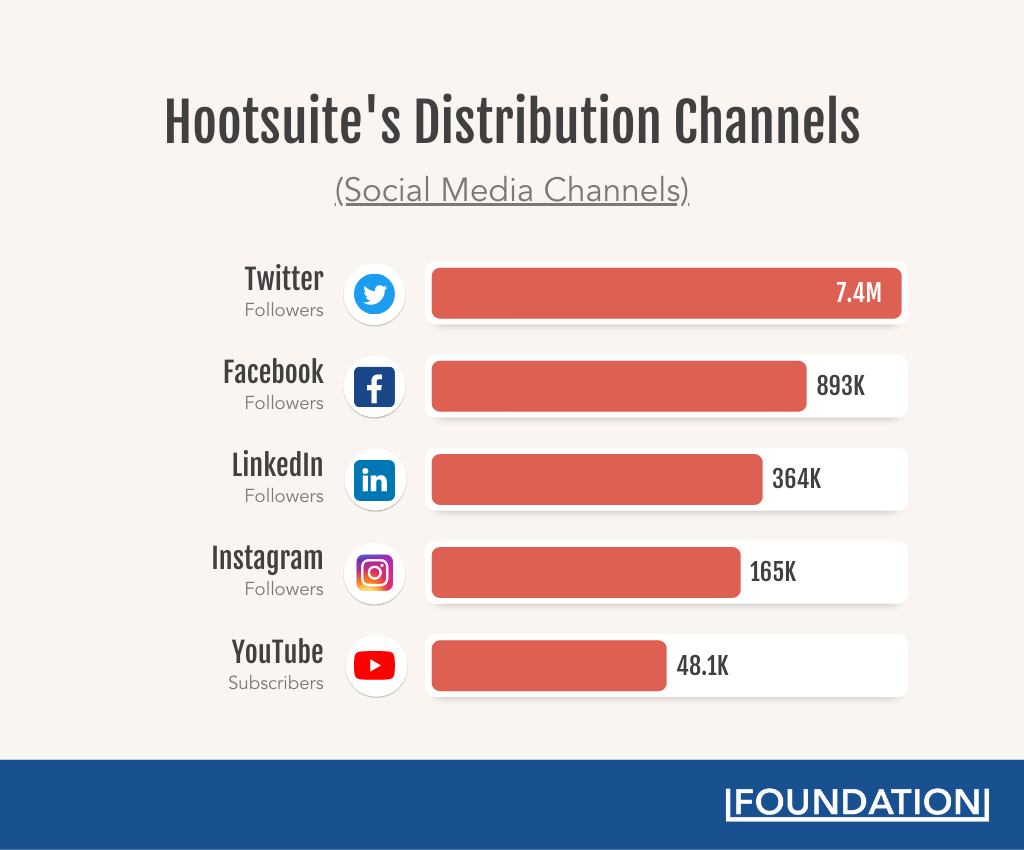
Repurposing their content not only saves them from creating all of their content from scratch, but it also makes their content easier to scale on different platforms.
In other words, the Hootsuite audience can choose the kind of content they love to consume from the variety on the menu.
Nailing content-market fit is critical if you want to succeed in your marketing efforts. Content-market fit simply means repurposing existing content into a format that suits a specific channel and distributing it on that channel.
It’s not enough to create or distribute content alone.
You need to treat content as an investment. That means knowing which content works best for each channel and using it to your advantage.
Hootsuite understands the power of treating content as an investment. The social scheduling company’s blog attracts over 4 million organic visitors every month.
Here’s what their search scorecard looks like:
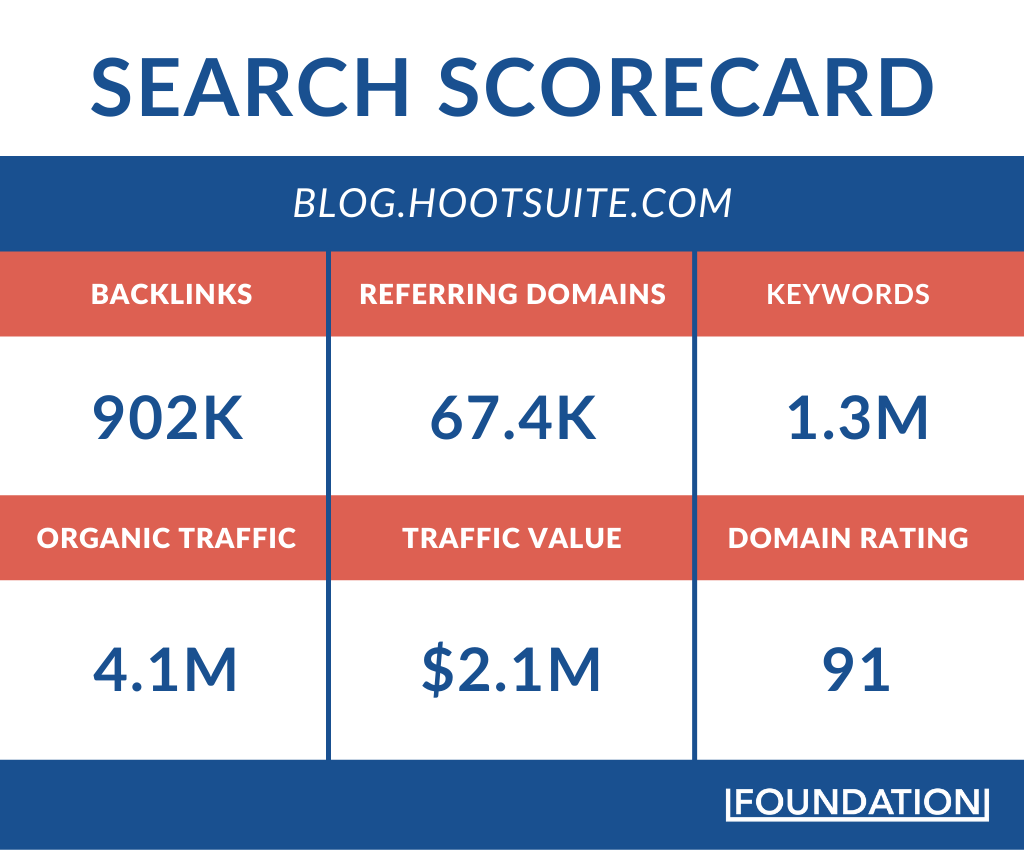
Hootsuite has used a collection of in-depth guides, reports, infographics, and other content types on their website to build a solid customer acquisition channel, with organic traffic worth $2.1M. Any brand looking to compete with Hootsuite should have as much cash in their pocket to spend.
With such impressive search stats, some B2B brands might just fold their hands and do little or nothing more to expand their reach. But not Hootsuite.
The company knows that not everyone in their audience likes to read or has the time to consume a 2000+ word article. So, they transform these blog posts into infographics, videos, etc.
For example, Hootsuite originally published this Instagram Hashtags Guide in 2016:
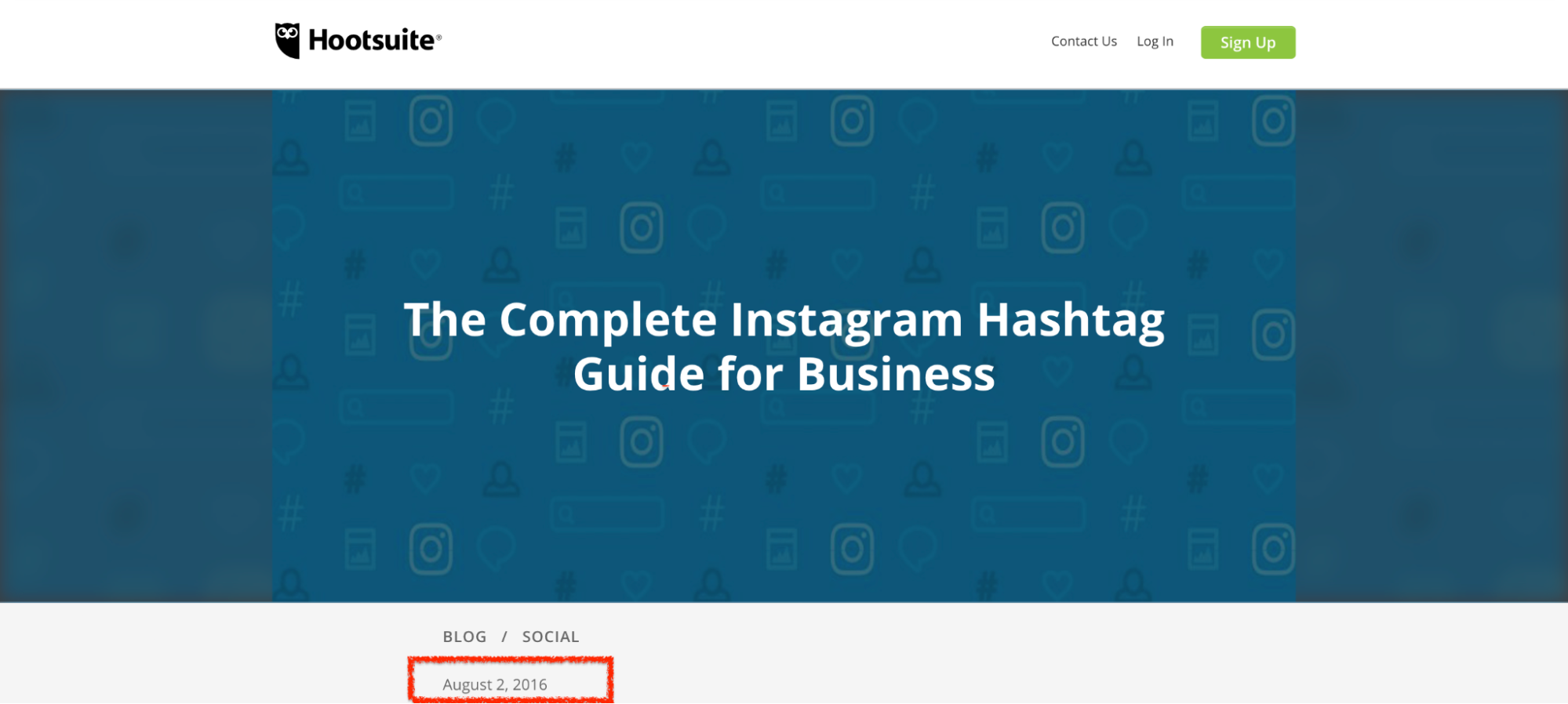
The asset generated less than 3K organic visits when it was first published, and even after four years, the traffic was less than 10K. However, since the content was updated in 2021, the piece now generates 232K organic visits every month.
This is what the asset looks like now:
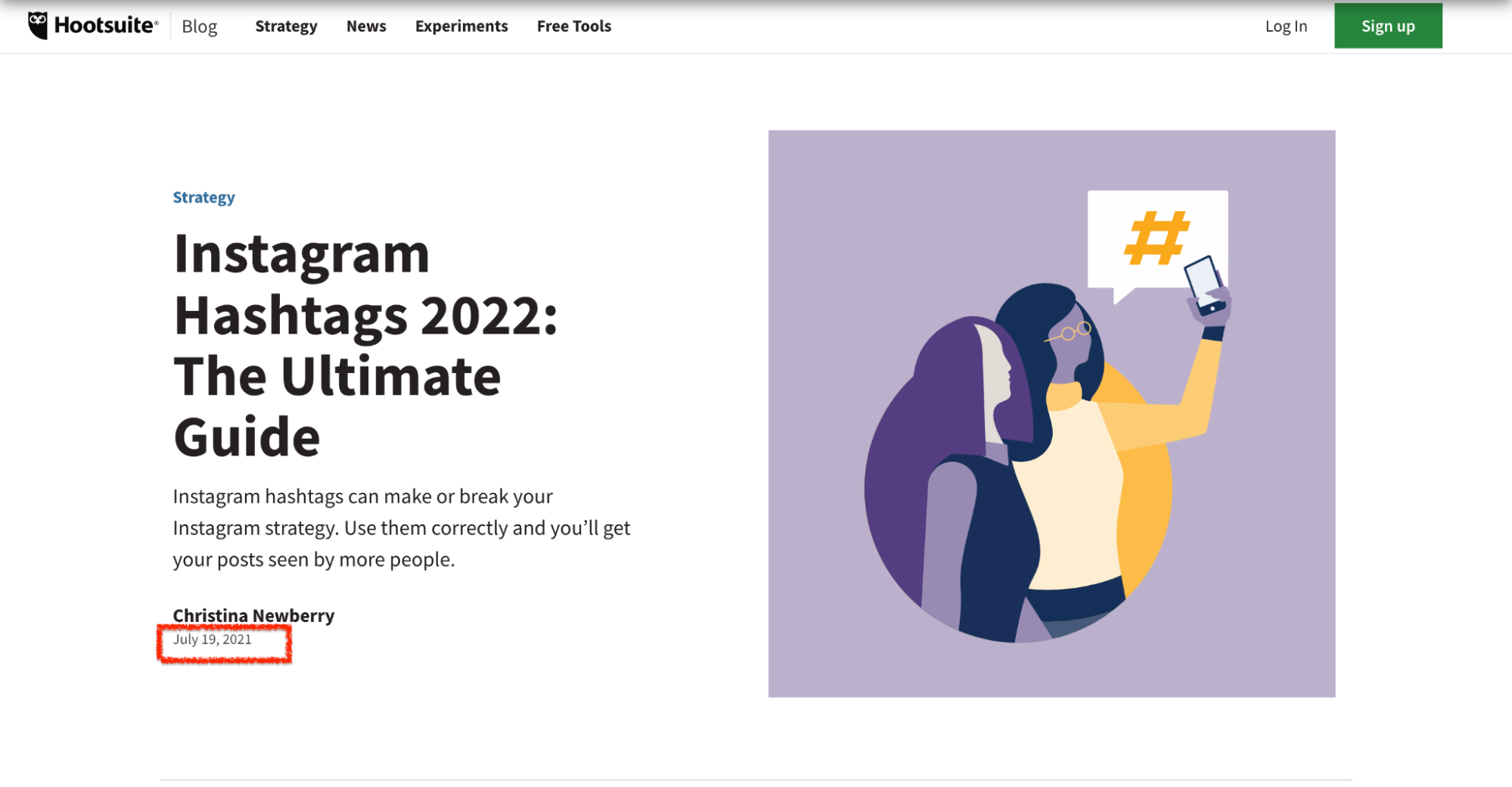
What changed?
Well, Hootsuite embraced content repurposing.
They identified the content piece as an asset with great potential, updated the piece, republished it, and then remixed the content.
Here’s what Hootsuite’s repurposing menu for this piece looks like:
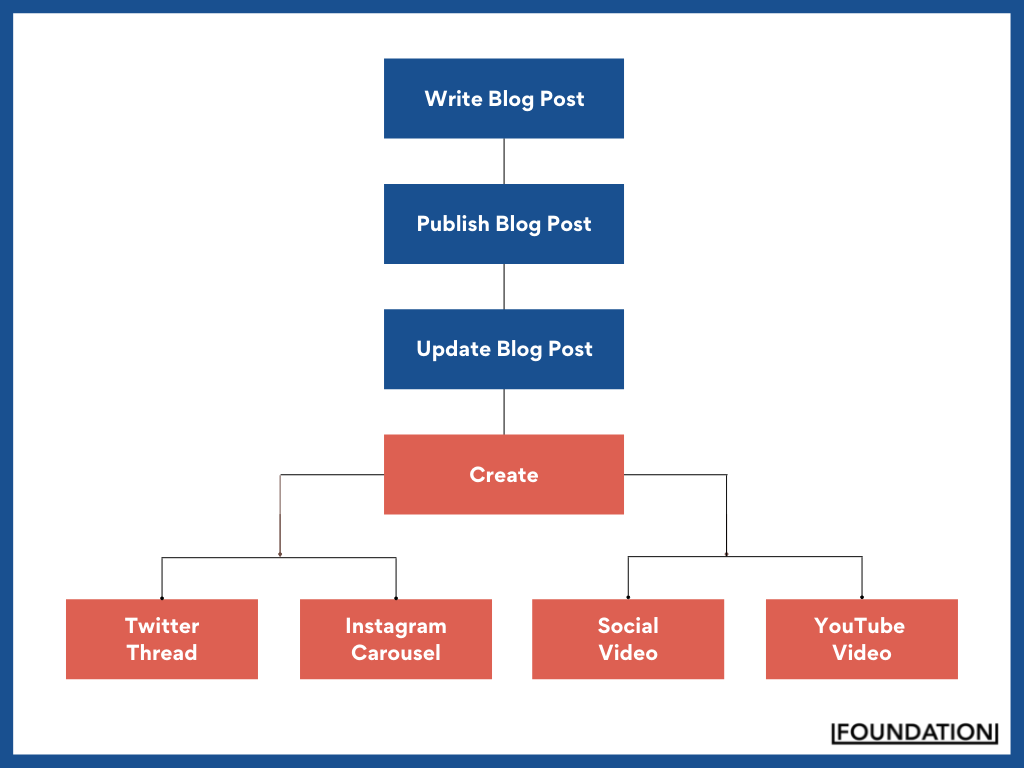
Hootsuite first updated the published content, then repurposed the long-form asset into this 6-minute video for YouTube:
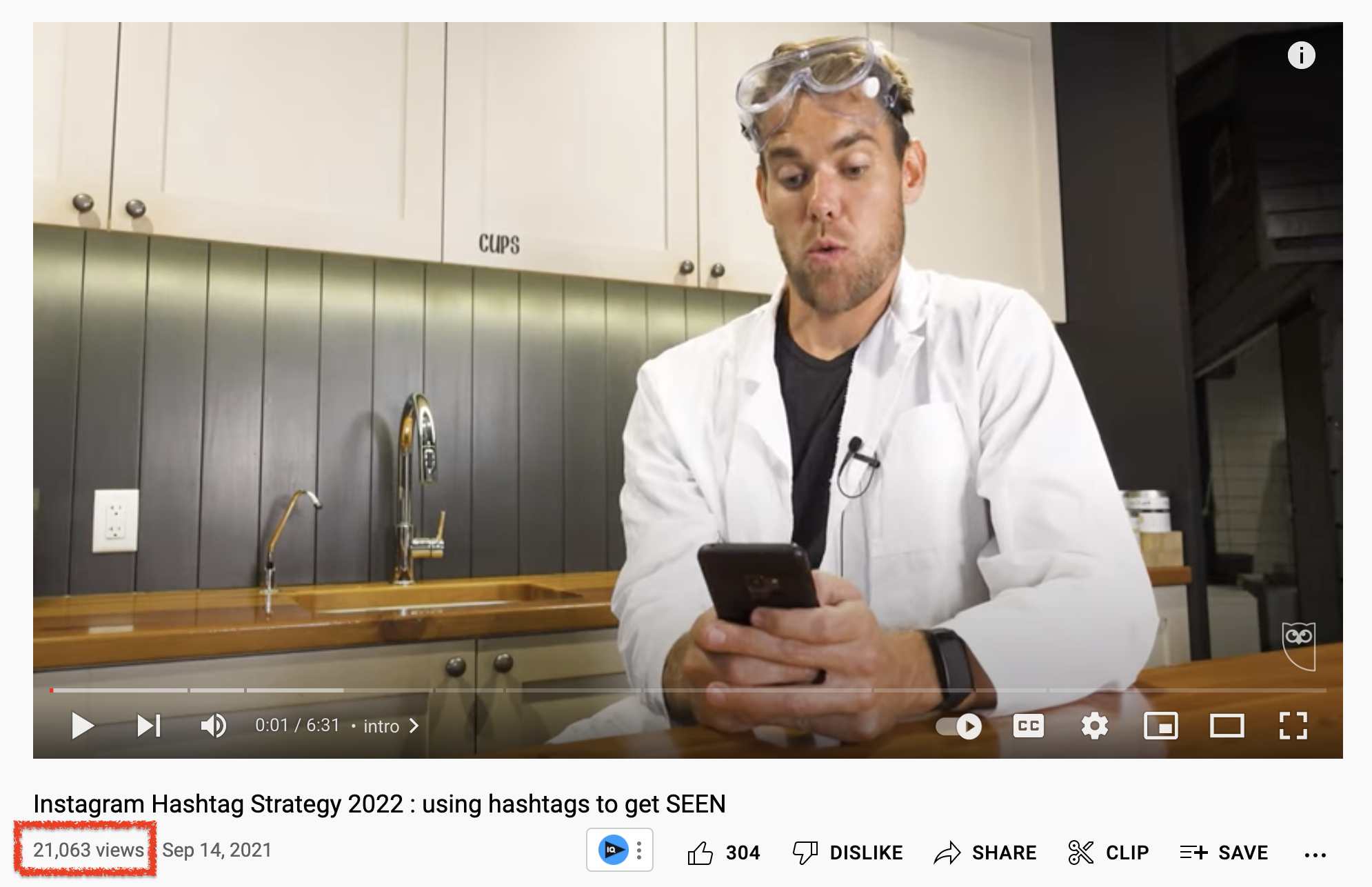
The video performed really well, generating up to 21K views in less than a year.
The brilliance I see in this video is how Hootsuite used long-tail keywords to break up the YouTube video into chapters. Long-tail keywords like:
-
Why use hashtags?
-
How do hashtags work?
-
How do you tell if your hashtag is working?
-
How many hashtags should you use?
-
How do you find good hashtags to use?
-
Different categories of hashtags
-
How do you hide your hashtags?
-
What happens if you use a banned hashtag?
These keywords are also used in the long-form guide.
The question “How do hashtags work?” has 800 people searching for answers every month, and Hootsuite’s guide shows up first every time to offer direction:

But Hootsuite didn’t stop there. They also embedded the YouTube video in the blog post and made the table of contents more robust:

Hootsuite also repurposed the content to a carousel on Instagram, generating more than 1K reactions:
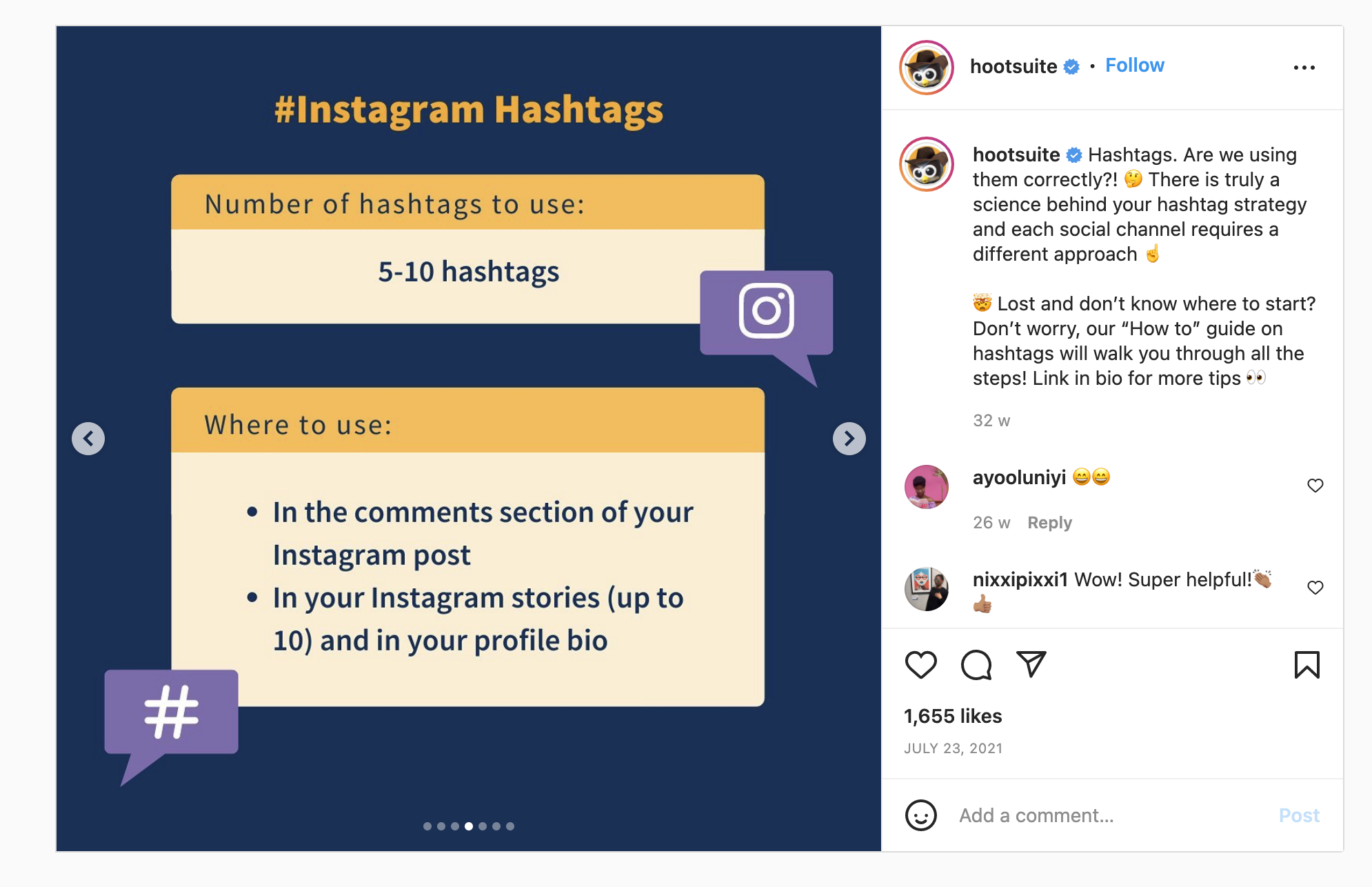
Notice how these repurposed content were short, digestible, and perfect for the channel used. These are some ways Hootsuite serves its content hot, fresh, and consistently to its audience.
So how do you repurpose your B2B SaaS content and delight your audience?
Let’s go over six other ways Hootsuite pulls this off.
Like what you’ve seen so far?
Get early access to the latest insights that aren’t published anywhere else.
SUBSCRIBE NOW
6 Ways Hootsuite Repurposes Content
1. Turn a Webinar Into Bite-sized YouTube Videos
B2B audiences love webinars.
As a result, some B2B brands source subject matter experts to deliver a kickass presentation to their audience.
If you host webinars, you need a way to preserve the value of the content shared beyond a few hours. Sometimes, posting the recorded webinar content on your website or YouTube channel doesn’t attract enough views.
That’s because your target audience is full of busy people who often learn on the go.
Hootsuite understands that not every one of their audience would have the time to watch a long recorded webinar. So, they repurpose them:
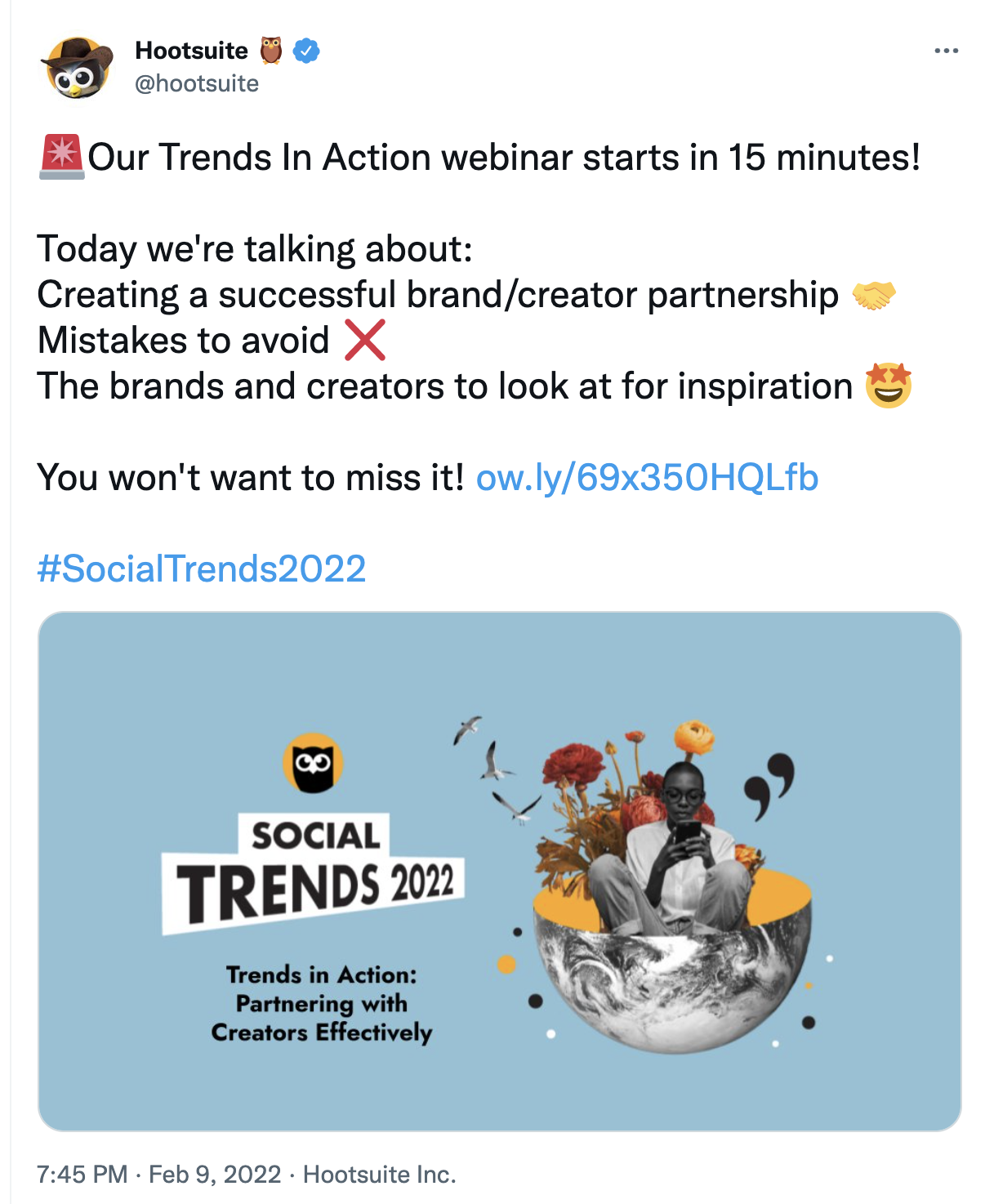
Hootsuite summarized the insights from this webinar into a less than 2-minute video:
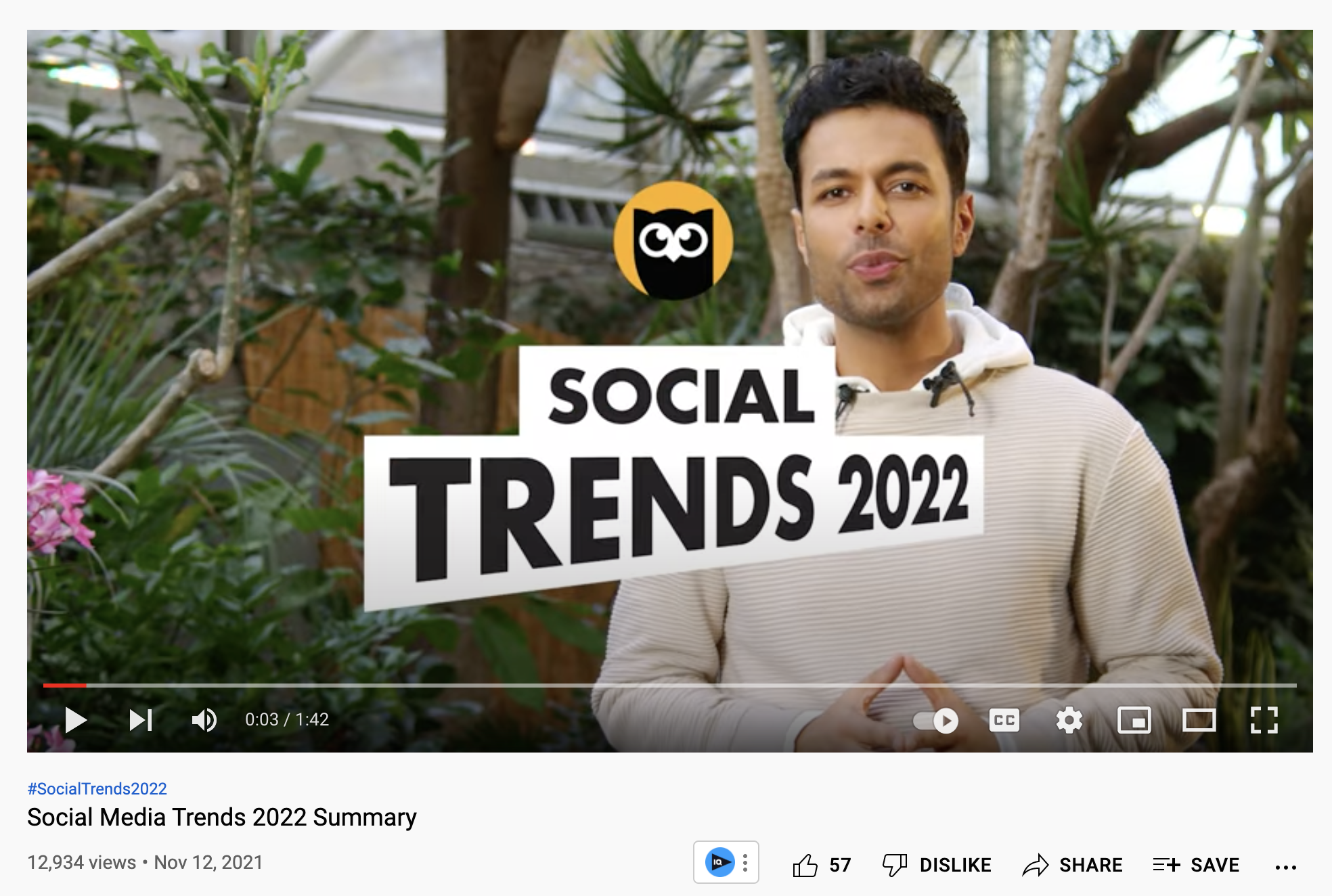
I’m not sure how many people registered and showed up for the webinar, but I deduce it may not have been as many as the 13K people who enjoyed snacking this video.
And this video might just be the push they need to go watch the full webinar or read the full report and corresponding pieces.
They also summarized each trend in this Twitter thread:
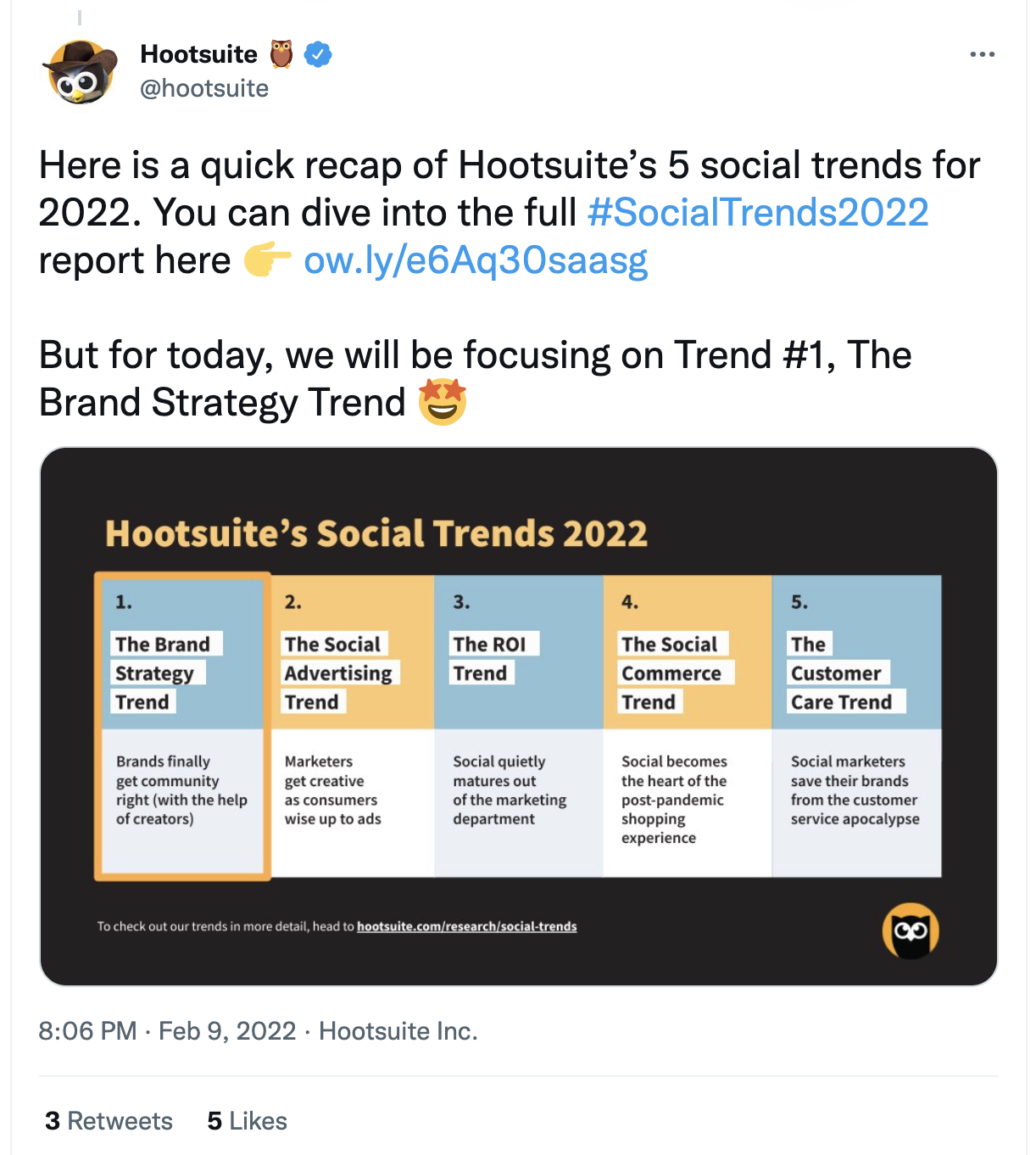
And they showed their audience how to apply one of these trends:
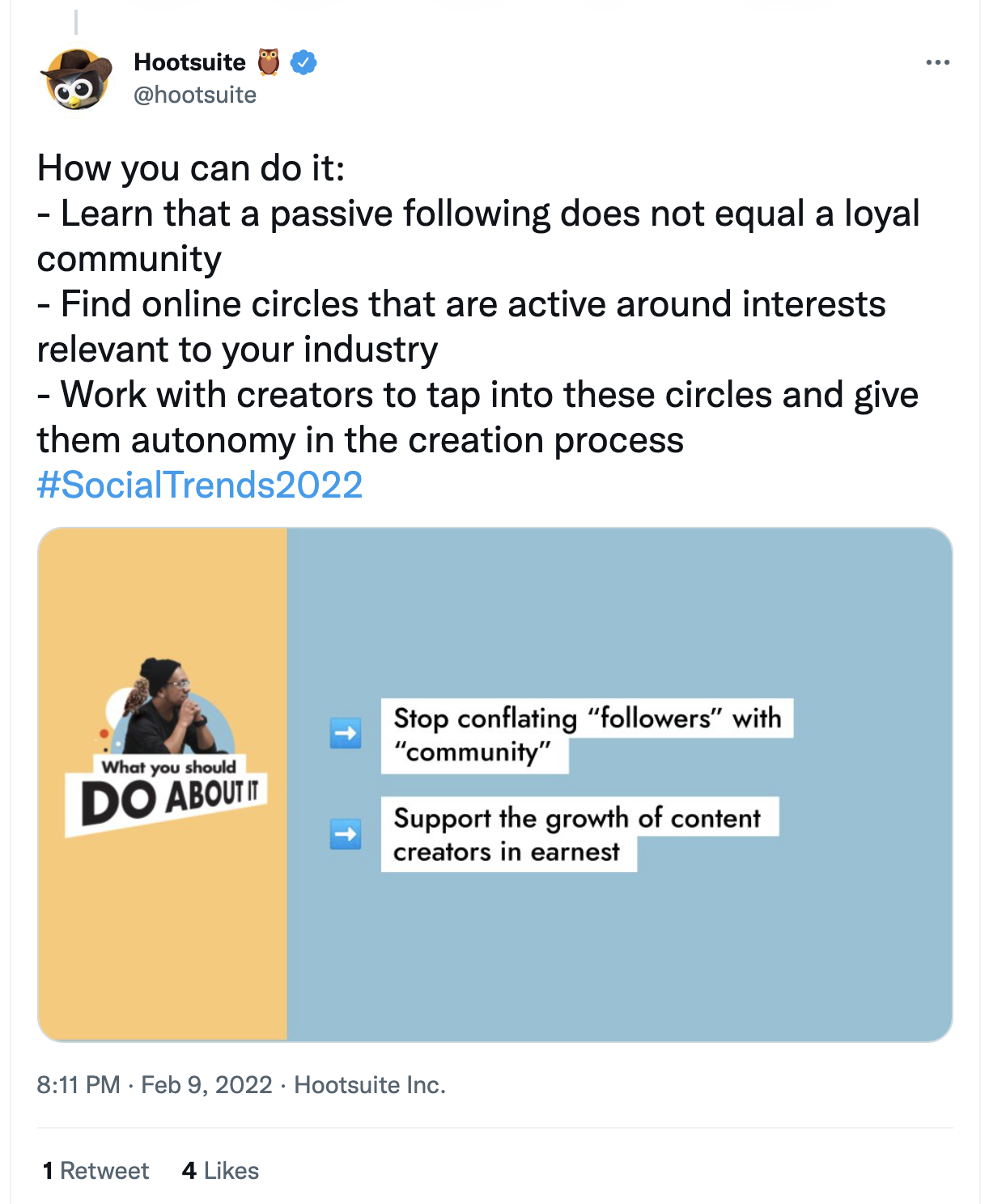
Did I mention this webinar was a trends report before it was dismembered?
Yup! It sure was.
If you have solid original research, you can go beyond creating social graphics.
Repurpose that piece of content into a webinar, and invite niche subject matter experts to share insights with your audience.
Turn the webinar into a short video summary for YouTube. Share subtitled excerpts of the webinar with your audience on LinkedIn and Facebook. Remix and distribute the content on different social media platforms you already leverage.
2. Turn Conversations with Subject Matter Experts Into Content
When you go out of your way to get guests for your podcast or video, you want to make the most ROI out of that investment.
Hootsuite interviewed Jamie Byrne, YouTube’s Senior Director of Creator Partnerships, for the Social Trends 2022 report.
The social media scheduling company didn’t stop at just including tips from the interview in the report. They also turned the interview into a 1500+ word blog post that highlighted the key insights he shared:

The page has generated over 50 backlinks in less than eight weeks. Of course, this might not seem like a lot, but if it keeps growing at this pace, it might generate up to 500 or more backlinks before the year is out.
They also repurposed this post into a carousel that details key insights from the interview:
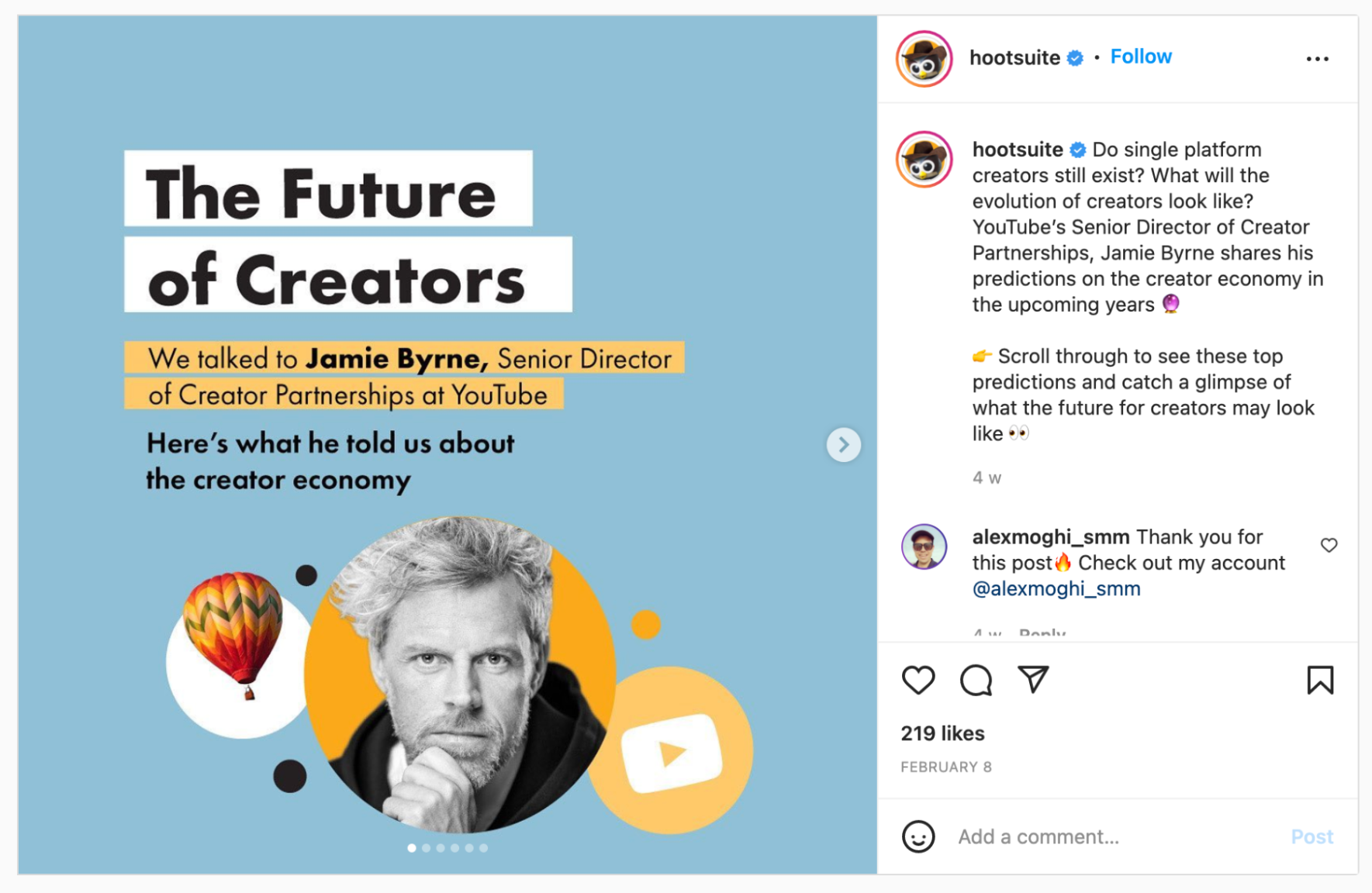
The posts generated over 200 reactions. Jamie Byrne also shared the post with his Twitter audience:
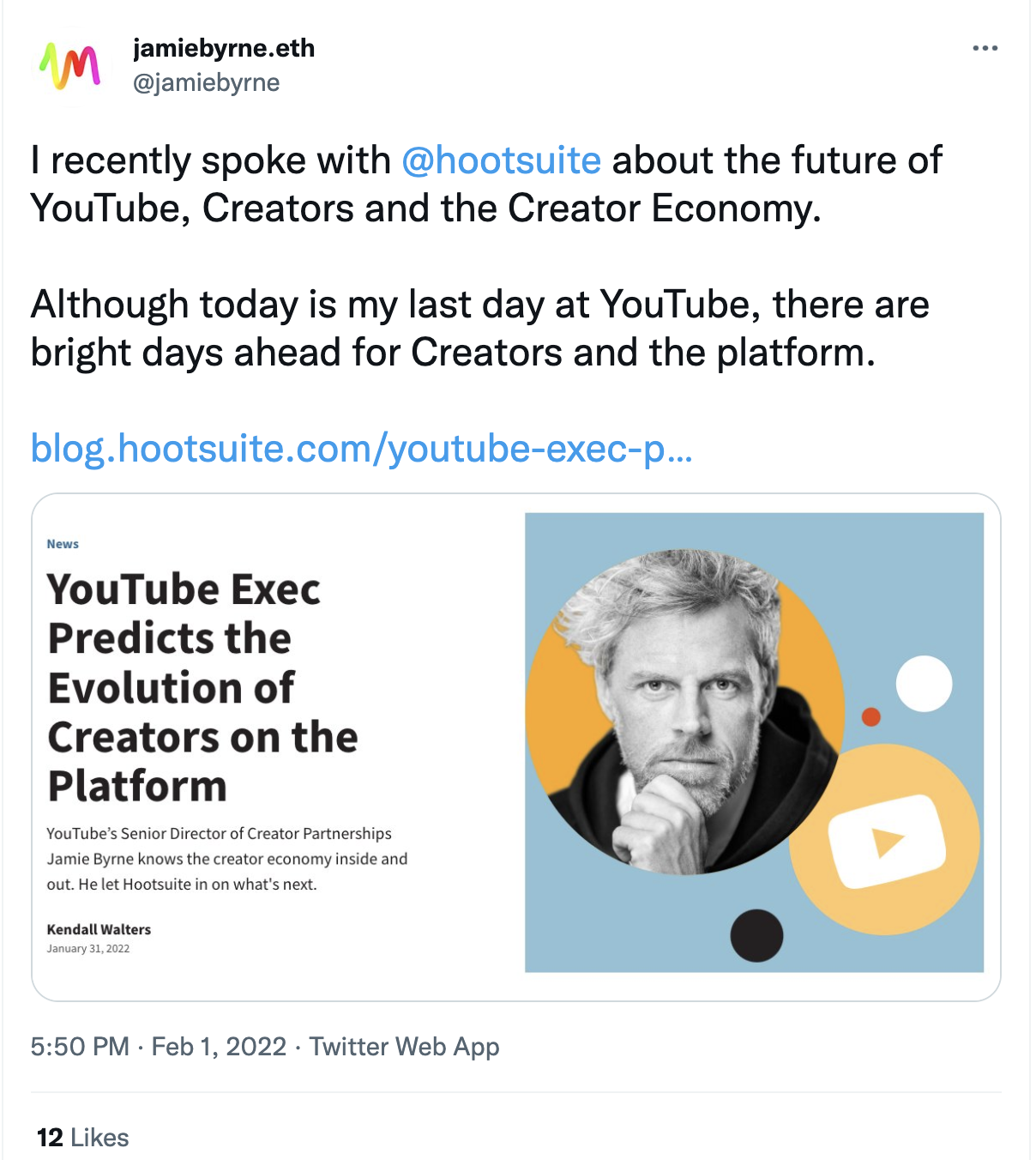
If he had over 10K followers or a good number of his current audience engaged with this content, the effect would have been even greater than this.
You can start by finding an evergreen video or podcast, repurposing the content into interview-style blog posts, carousels, bite-sized (subtitled) videos, or even reports. Get the influencers you featured to share it with their audience. That’s how you get more eyes on your content.
3. Turn Guides Into Interactive Instagram Videos
Another thing Hootsuite does well is to turn a high-performing blog post into a video for social media.
Take this how-to guide for newbie/aspiring social media managers, for example.
This post generates 1.2K organic monthly visits, though it once attracted as high as 14K visitors. Hootsuite repurposed this piece of content into a video that has generated over 700 reactions on Instagram.
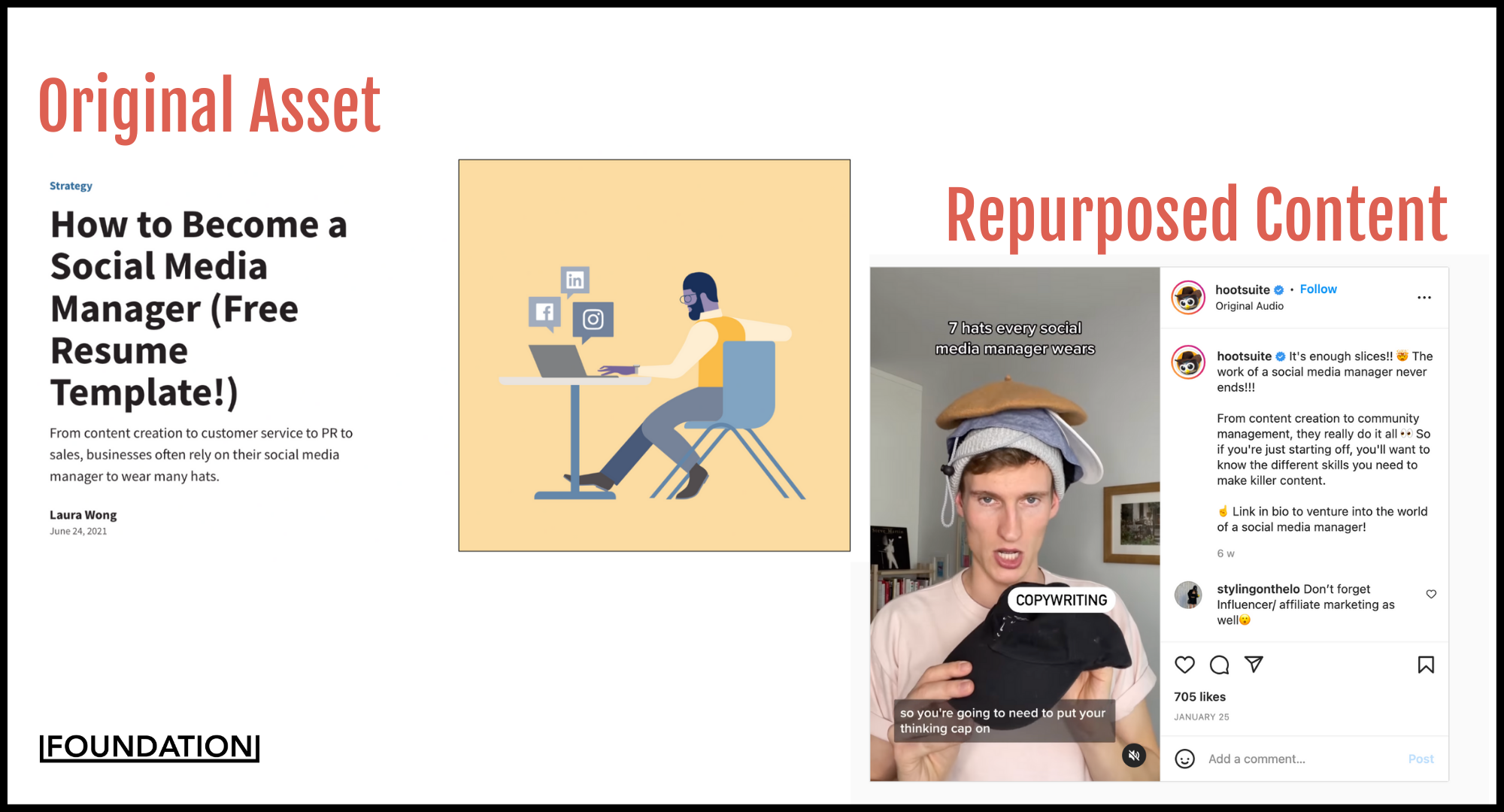
I believe the asset would have contributed a little to the slight increase in visits from as low as 1.4K to 1.8K in January.
You can turn your guides into engaging videos that summarize the pain points of your target audience as it relates to the subject and share other relevant info that will leave them feeling informed enough to make a sound decision.
4. Turn Insights From Experiments Into Case Studies
Some marketers might argue that case studies are a form of social proof.
They are right to think that way.
69% of content marketers use case studies to show prospects about the benefits of their products/services. They use verified data and stories from customers.
Beyond customer stories, you can also conduct niche experiments, and turn those insights into in-depth case studies to share those findings with your audience.
Hootsuite, for example, didn’t sit on insights from their 7-second TikTok experiment. Instead, they turned it into this actionable case study:
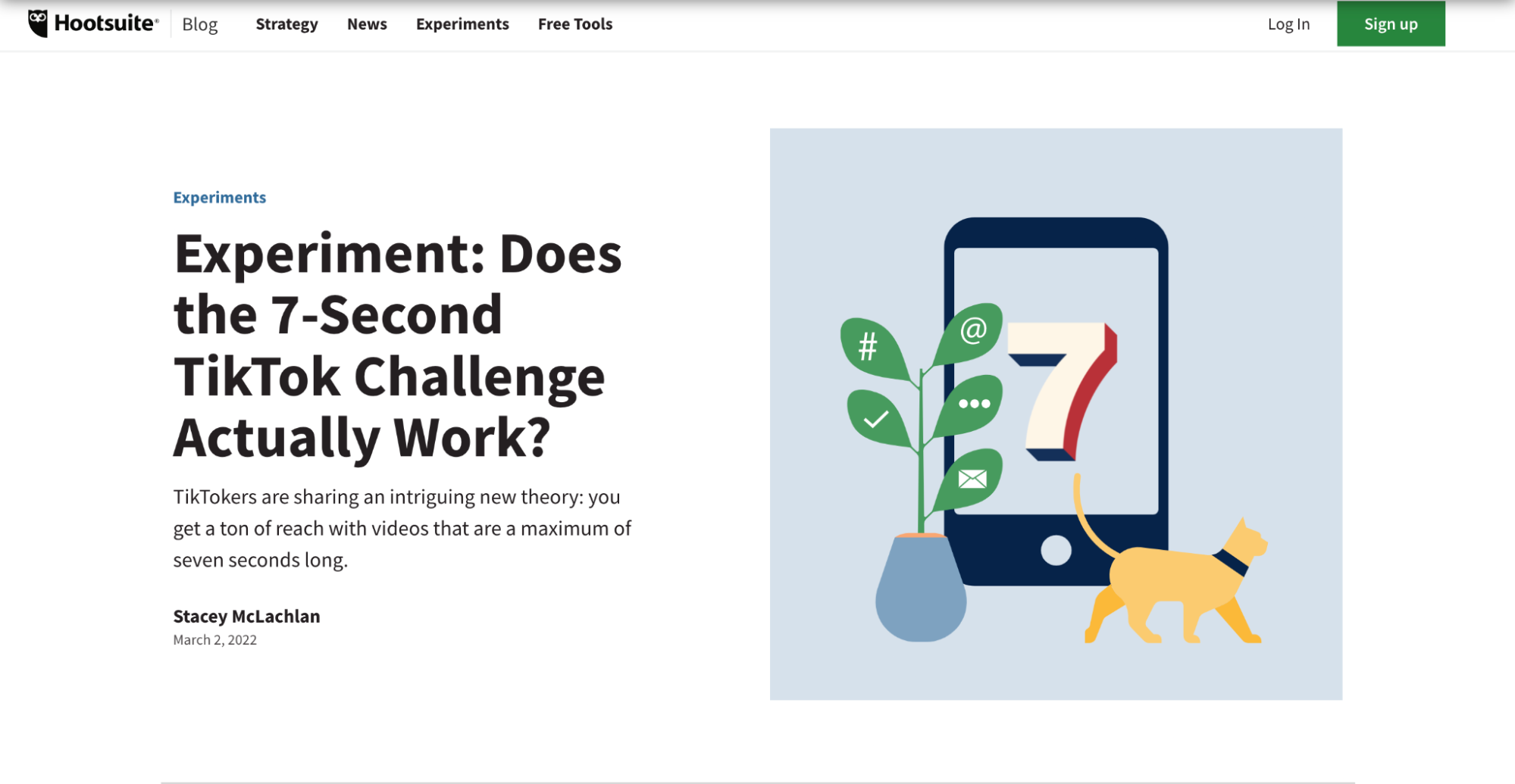
They break down their process in stages to help readers understand Hootsuite’s discovery, and the readers can implement the strategy if they choose to.
A case study like this one shows your readers that you know how to analyze and turn data into actionable content pieces. It boosts your credibility and establishes authority in the eyes of your readers.
You can gather metrics from social media, SEO tools, traffic performance, and other internal data from experiments, and turn them into a masterclass case study.
Look for data you have collected in the past and see if you can turn it into something readers would find interesting and valuable.
To distribute this content, you can turn your findings into a Twitter thread, Instagram carousels or videos, an answer on Quora or Reddit with links, a special offer for your email subscribers, and more channels to get more eyes on your content and ultimately boost conversions.
5. Turn Statistics Reports Into Social Graphics
Another way to spin your report into something your audience will enjoy consuming and distributing is to turn-key stats into a social graphic.
For example, Hootsuite released a digital report for 2022. To get more eyes on the content, they turned different stats into social graphics suited for different platforms.
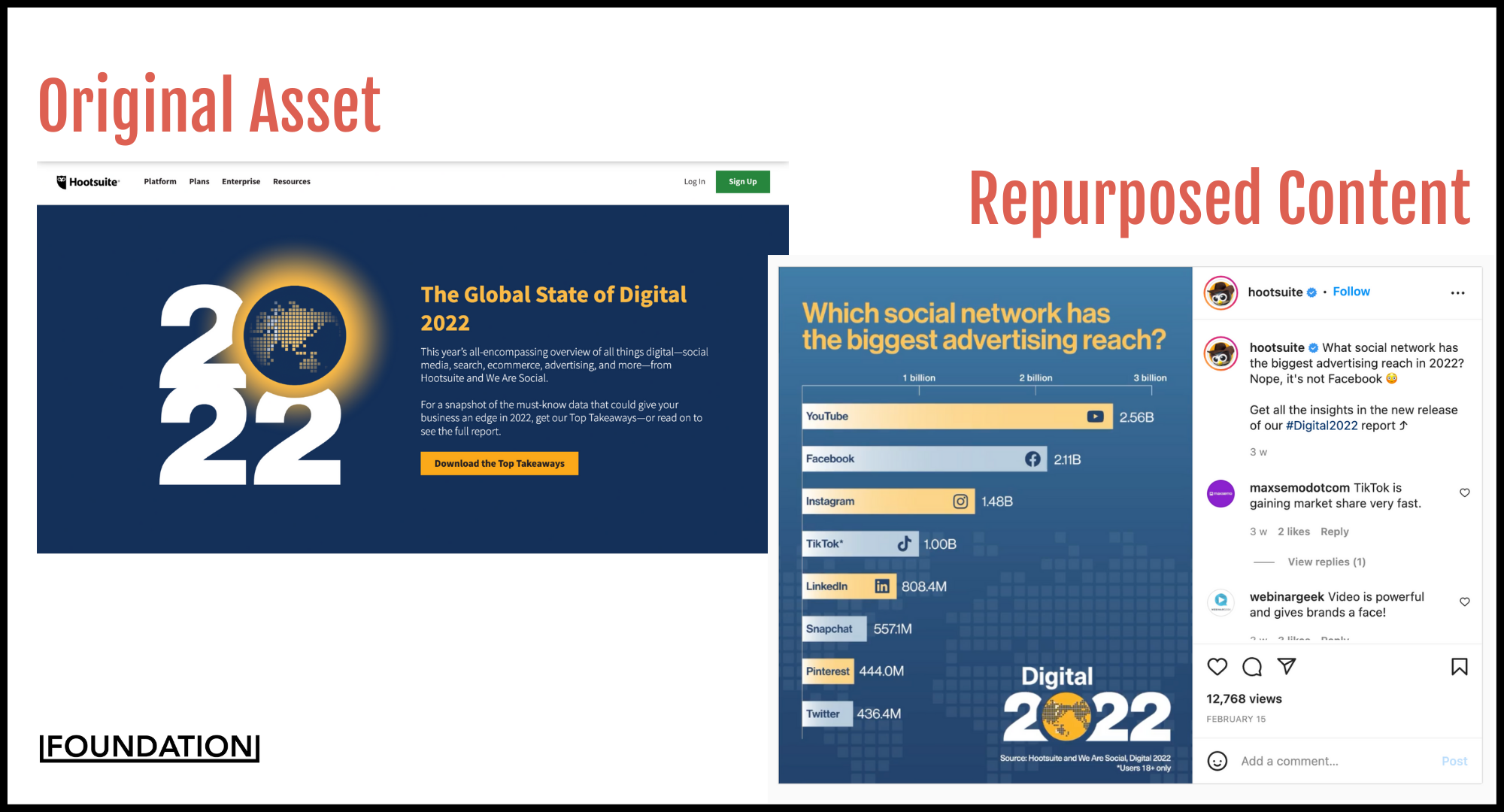
The graphic has over 12K views. Obviously, a post like this will generate tons of views, especially because of its title.
Many business owners and individuals advertise most of the time. Knowing where they should focus their efforts more is a big deal to them. So, they would typically be drawn to a post like this.
Hootsuite also repurposes for LinkedIn:
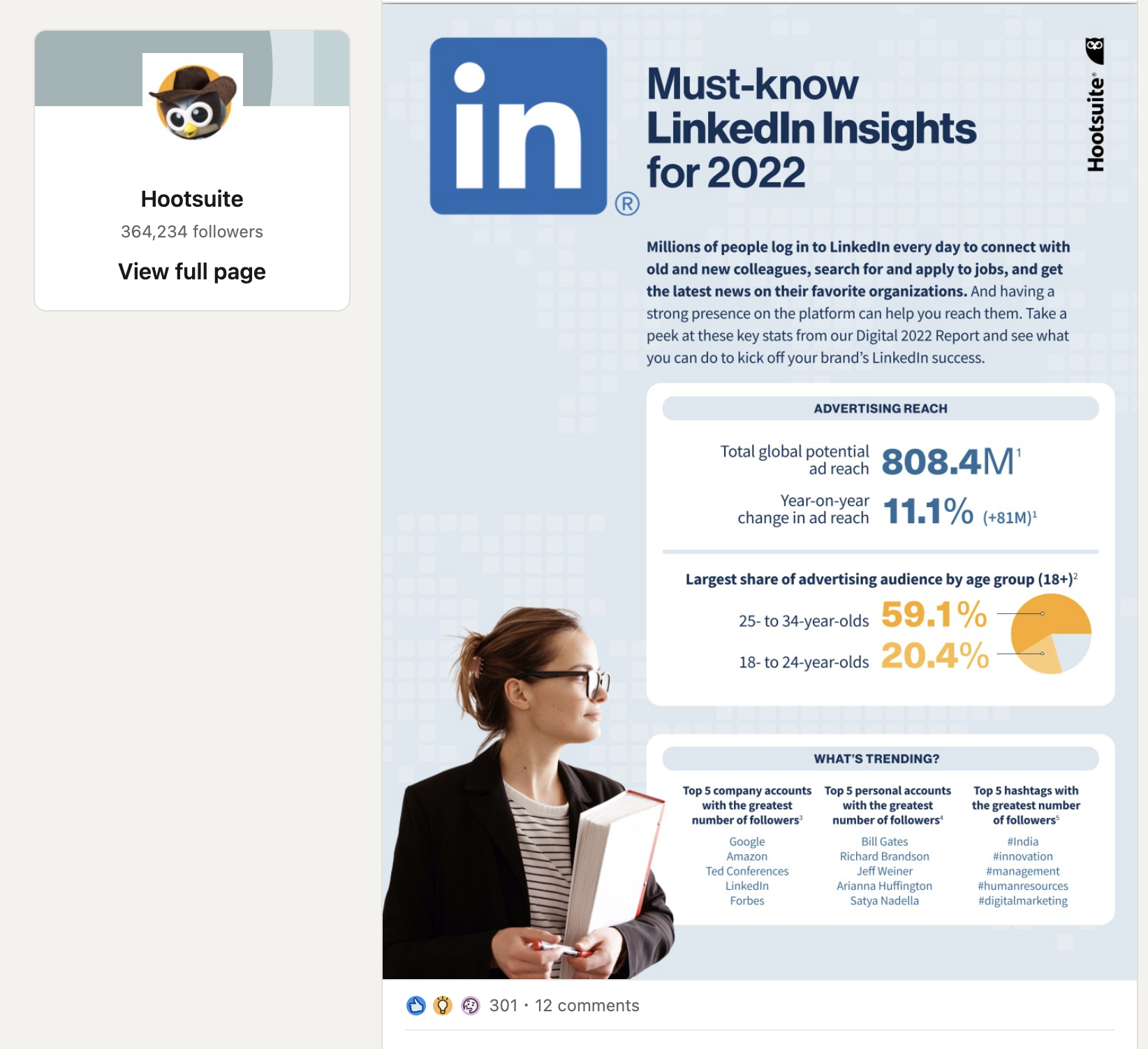
In this case, they chose an excerpt that LinkedIn users would find most beneficial, and it generated over 300K reactions and comments.
If your current social media strategy doesn’t accommodate adding statistics to your content mix, you should consider revising your strategy.
You can use a stat graphic on your Instagram stories and save it to highlights. You can also choose to use it on Twitter to validate a message.
To be fair, you should also include the graphics in your Instagram post feed so your audience can easily find them when they land on the page.
6. Create a slide deck for SlideShare
Hootsuite also repurposes reports into slide decks and shares them on SlideShare.
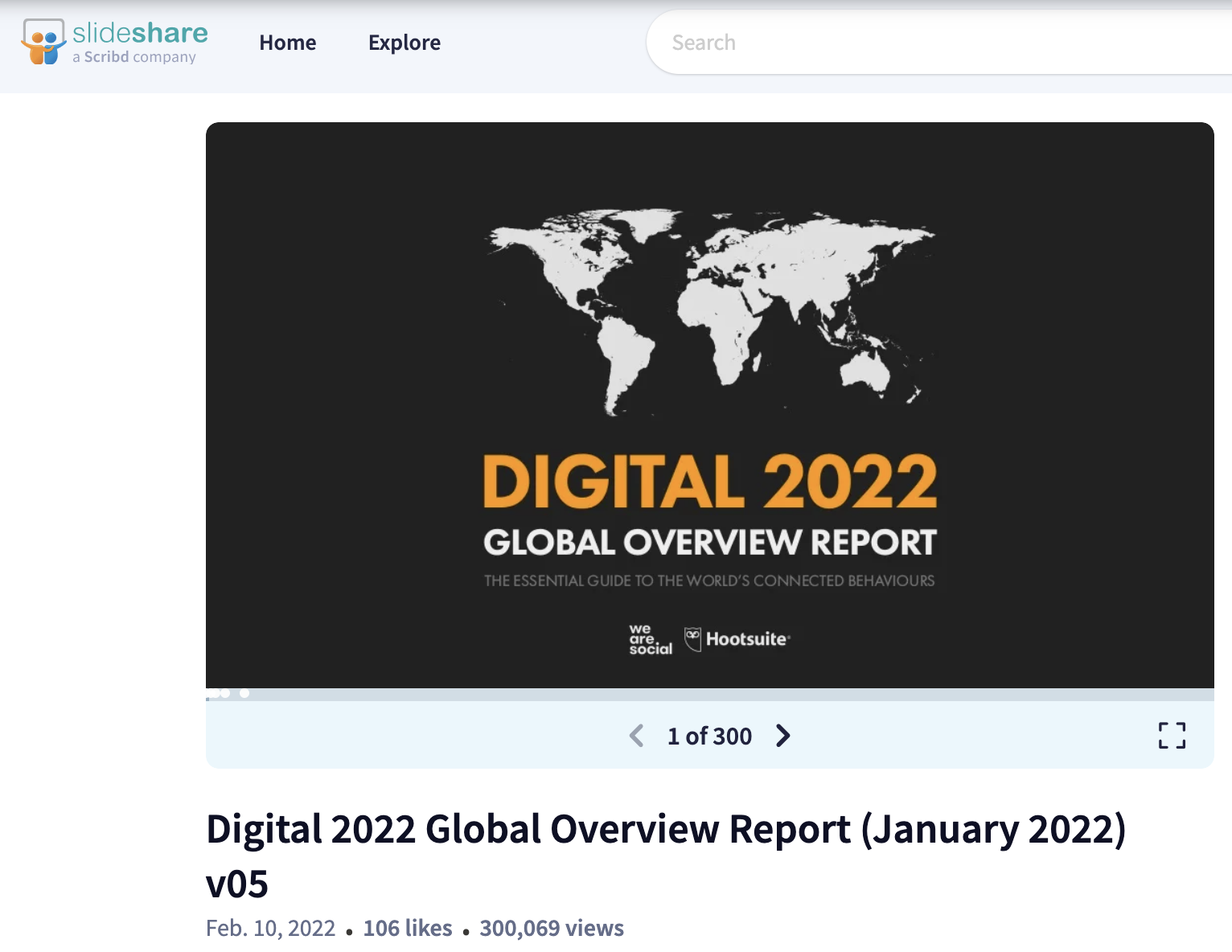
This digital global report has generated a little over 300K views. That’s an excellent reach for a content piece that was published about a month ago.
If you have a data report to remix, you should turn it into a slide deck. Include critical data points from the report, and make sure your design is visually appealing.
SlideShare gives you an extra chance to reach more people, including those who have never heard of you before. That single content piece can potentially generate more views than Hootsuite’s, and it can direct more qualified leads your way who will eventually become paying, loyal customers.
What Hootsuite Can Do Better: Active Over Reactive Repurposing
Hootsuite sets the pace well when it comes to repurposing content to suit each channel and distributing.
However, one place they fail to hit the mark is in the way they repurpose.
From my observation, it’s clear that Hootsuite embraces active repurposing for its reports and holds on to reactive repurposing for other content types.
The difference between active and reactive repurposing is this:
- Reactive:
You wait for content to be successful before kicking off repurposing
- Active:
You repurpose while creating the original content piece
Here’s a great visual showing the difference between the two:
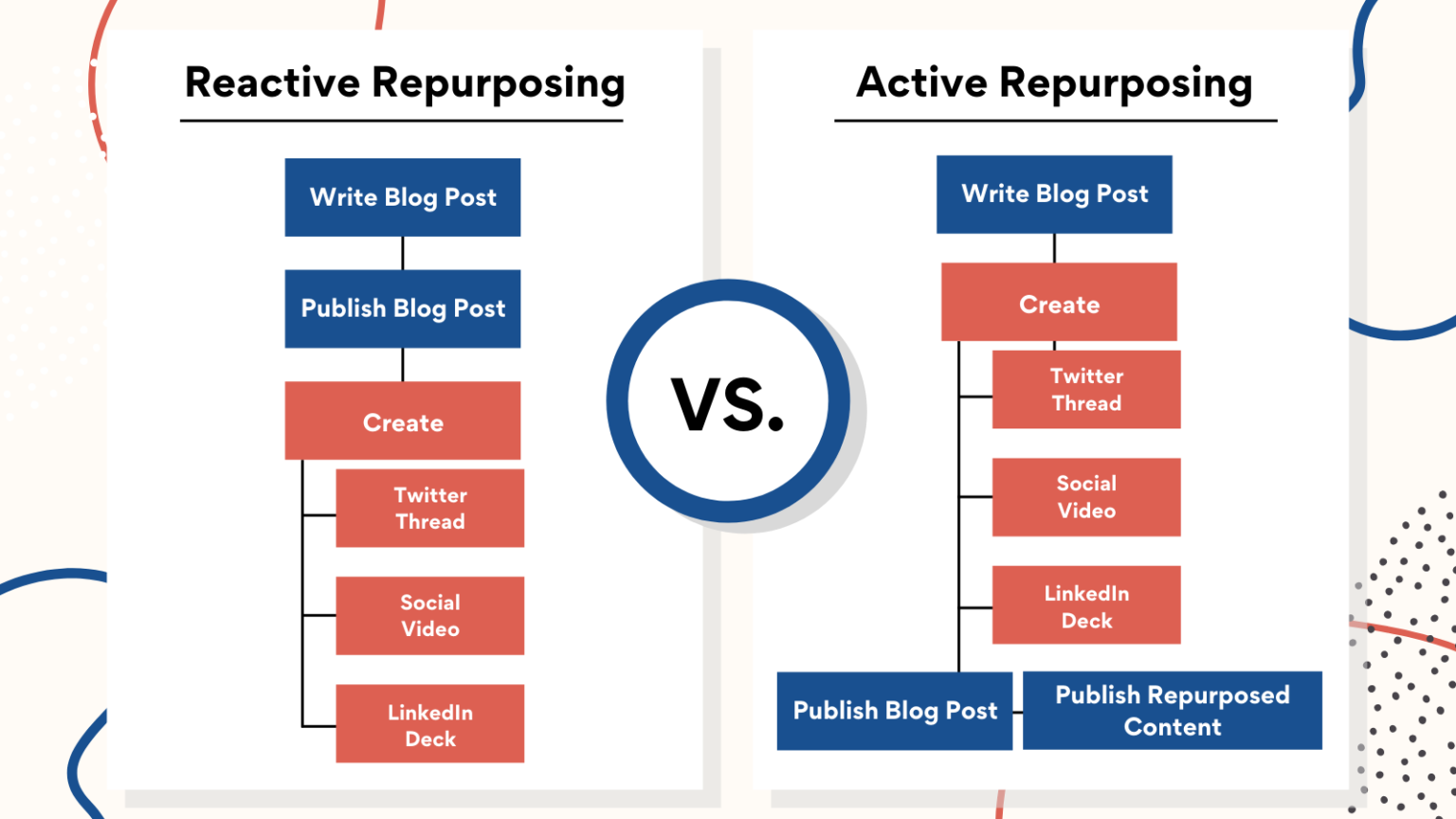
From the examples we gave, you can see Hootsuite repurposing most of its content pieces months after the original publish date.
When a published blog post gets a lot of traffic, they start to create multiple supporting content for different channels to get more eyes on it.
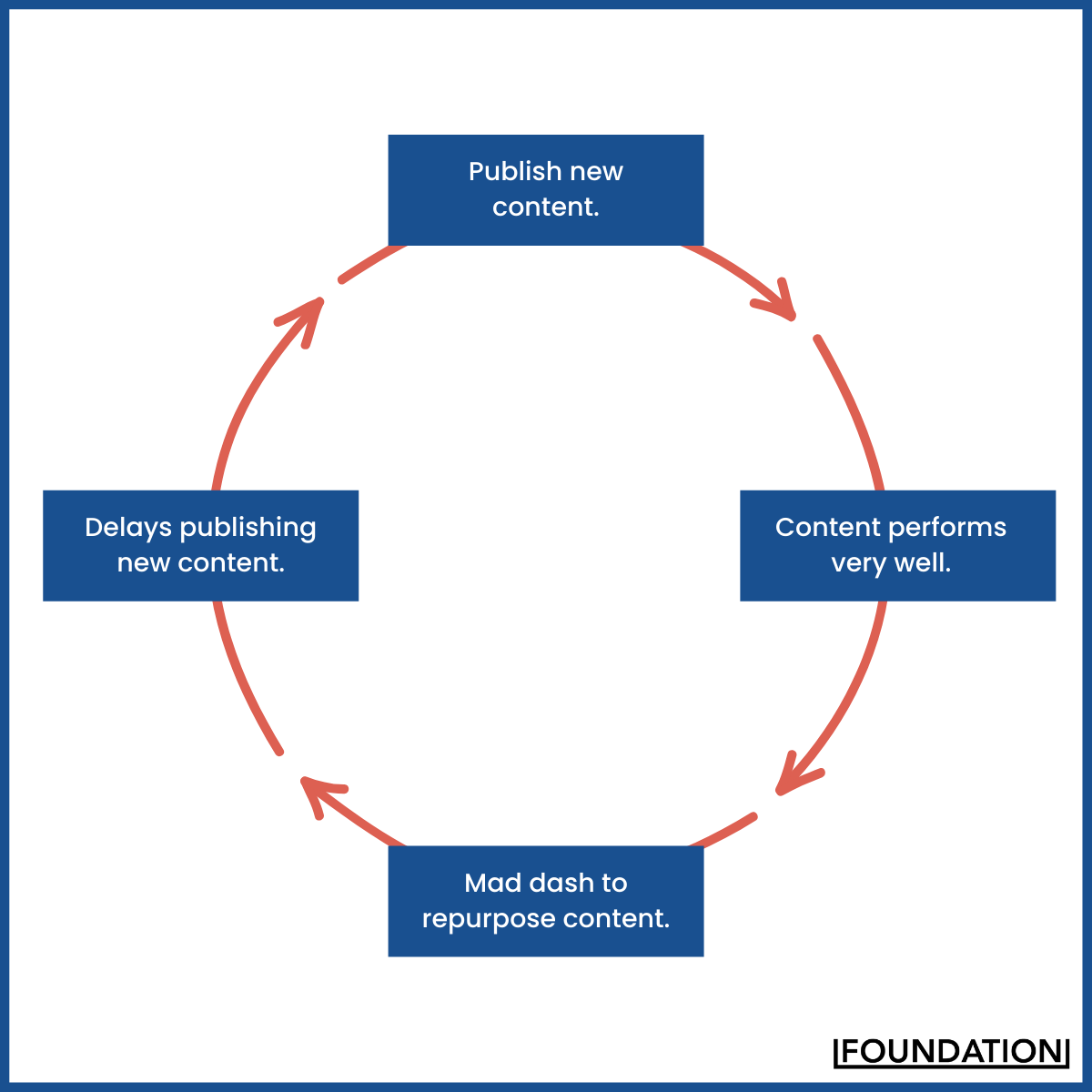
Relying on positive metrics to validate whether or not to repurpose a piece of content might work for Hootsuite, but what would work better is repurposing as they create the original asset. That means taking an active approach to repurposing.
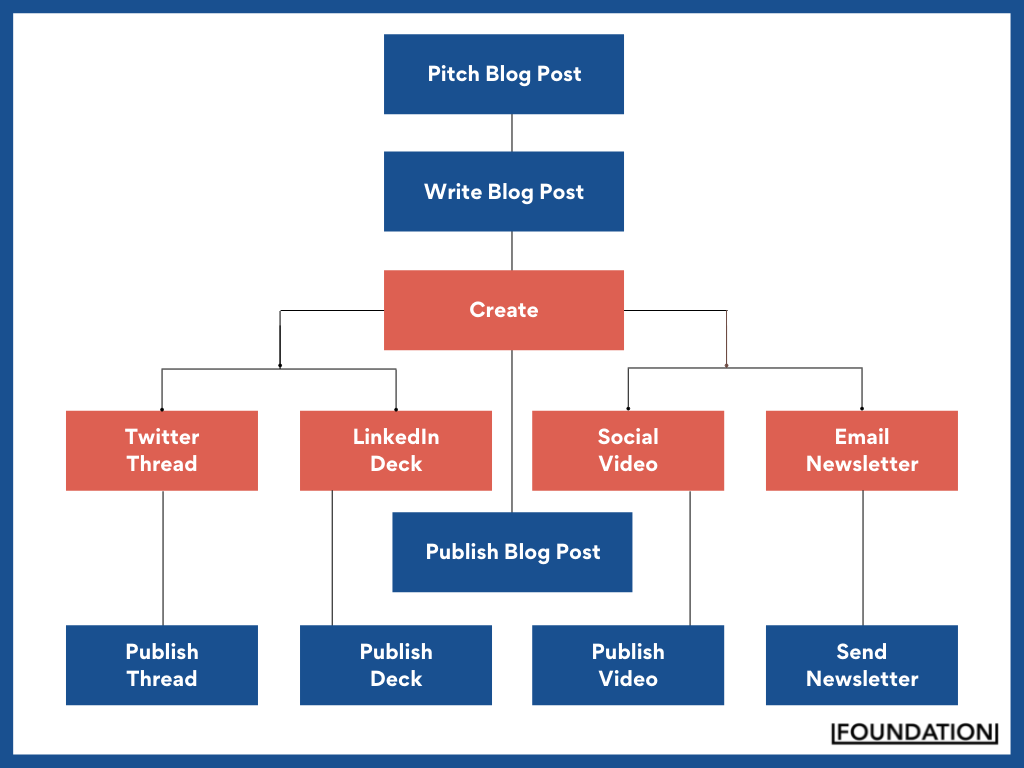
Hootsuite can turn parts of a report in creation mode into a carousel for IG, a deck for LinkedIn, a thread on Twitter, and a short video for YouTube. These are the primary channels Hootsuite leverages.
As a B2B marketing leader, active repurposing shows how confident you are about the content you create and its performance.
If you second-guess the value of your content to your audience and wait to see if it gains enough traction before repurposing, you might end up overwhelming your marketing team and miss out on potential opportunities.
You don’t have to give the same amount of energy to repurposing content for all platforms. You can focus on one or two platforms.
Like Hootsuite, choose your primary channel(s). Determine how long it will take to create the repurposed content alongside the original content. Then create those assets alongside the main piece.
You should create as much repurposed content as possible because distribution isn’t a one-and-done affair. You create once, remix in different formats, and distribute forever.
Wrap Up: Create Once, Distribute Forever
Now you know the different ways you can remix your content and increase conversions. You should embrace active content repurposing to smash your 2022 content goals.
Even if you don’t have a huge budget to fuel your content marketing efforts, you can start with repurposing existing or new compelling content pieces into formats that suit your primary channel. Distribute those pieces consistently, and you’ll start to see more traction, more engagement, and more potential conversions.
Get The Latest SaaS & Marketing Insights Delivered To Your Inbox
Research, exclusive insights and information that isn’t published anywhere else.
SUBSCRIBE NOW















![Toni Kroos là ai? [ sự thật về tiểu sử đầy đủ Toni Kroos ]](https://evbn.org/wp-content/uploads/New-Project-6635-1671934592.jpg)


